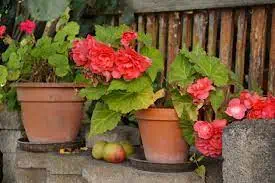If you have just discovered your love for growing plants, you are probably considering planting some begonias. You can grow these both outdoors and indoors in your garden. The beautiful flowers and foliage of the plants will definitely add to the beauty of your house. Now, let’s talk about begonias how to grow and care for them.
You have to make sure the soil begonias are planted in stays moist, and the plants get adequate but not too much direct sunlight. Begonias are kinds of succulent plants that can be annuals or perennials. With regular simple care, they can thrive as houseplants or garden plants.
Here, I will talk about how to grow and take care of begonias to have beautiful flowers and foliage in them. Before that, you should know more about begonias and their different types.
Table of Contents
Begonias and The Different Types

If you have never grown a begonia plant before, you should know about it more before getting one for your house. You should learn the basics of taking care of begonias. Also, there are about over 2000 types of begonias. These varieties come in different shapes, sizes, and colors.
Some are easier to maintain as houseplants, but many grow better outdoors. Again, some give different colors of flowers while others have lovely foliage.
Begonias are tropical and subtropical perennial plants that live for years with proper care. You will also find some types of begonias sold as annual plants. These plants thrive in the winter. With the approach of summer, they may start to wither.
But they are perennial plants. You just have to focus more on their care to keep them alive to give you beautiful flowers in winter season. So, you have to first figure out the type of your begonia for taking care of it.
Now, let us know about some popular types of begonia plants.
- Wax Begonias: These are fibrous root begonias. These are popular for bright flowers and a tight mound of waxy foliage.
- Angel Wing Begonias/Cane: This evergreen begonia has woody stems and joints. They grow upright. They are popular for both attractive leaves and flowers.
- Tuberous: Tuberous begonias such as Rieger begonias have tubers or bulbs. These are well-known for having large flowers.
- Rhizomatous Begonias: These Begonias are mostly admired for their foliage. They have different colors and sizes of flowers that look attractive.
- Rex Begonia: This type of begonias is a subcategory of Rhizomatous Begonias. They are popular houseplants.
How to Plant and Grow Begonias
There are mainly three ways to grow begonias. Beginner plant enthusiasts often get starter plants from garden centers or other green thumbs. On the other hand, experienced gardeners often propagate begonias from cutting plants or planting seeds. Plant and growing begonias from seed require hard work and a lot of time.
How to Plant Begonias in the Garden
As beginners do not have much experience of growing plants from seeds, they should get starter plants. If you want to plant begonias in your garden, choose a spot that has rich and well-drained soil. When you are not sure about the quality of the soil, mix some organic fertilizers before planting begonias. After planning the begonias, water them well.
Also, make sure the spot is not under direct sunlight. Begonias grow better under partial sunlight.
How to Plant Begonias in Pots

You may want to plant the begonia in a pot. In that case, choose a six to eight inches diameter pot that has holes in the bottom. This size of the pot provides enough room for the root to grow and helps plant growth.
The holes are necessary to let the extra water pass through the pot. The soil should also be loose enough to channel the water to the drainage holes. You can make the perfect soil mix for begonias by taking sand, cocopeat, and vermicomposting or perlite in equal amounts and mixing them.
This mixture will hold the moisture and let the extra water drain through the holes on the bottom of the pot. As the mixture is loose, the plant roots can also spread with ease. Add some bone meals to enhance growth and flower blooming.
After planning the begonia on the pot, water the pot well. The water will ensure the nutrients of the soil and bone meals can reach the plant.
You can put the begonias indoors, where the plant can get indirect sunlight all year round. Potting begonias also help get them indoors when it is too cold or sunlight outside. Direct sunlight is really not good for the plant. However, you should let it bask under the sun in the morning and put it back in partial shade or indoors after a while.
How To Take Care of Begonias
No matter what type of begonia you have, caring for them takes similar effort and time. Here are some things to consider:
Watering the Begonias
Most of the time, begonias die because of water issues. People either water them excessively or do not water enough. So, you need to know how to keep a balance. The soil of the pot has to be evenly moist. The pot should not be too dry or too wet.
Instead of following a daily watering schedule, check the soil first. Stick your finger about one and a half-inch inside the soil. If it is dry, water your begonia. If not, then wait for the soil to get dry.
Keep the bottom drainage holes clean so that the excess water can get out. The fungus can grow in begonia leaves if it stays wet too long.
Providing Sunlight
Now, you have to identify your begonia type to understand how much heat it will require. All begonias are tropical plants. So, they need a decent amount of sunlight to stay healthy. Some even need full sunlight. However, most begonias stay healthy under partial or indirect sunlight.
Begonias can get buried under too much sunlight and heat. Therefore, you should be careful they do not get direct afternoon sunlight. When growing begonias inside your home, place your pots in a spot where there is indirect lighting. Placing them near the window or balcony is the best way to keep indoor plants alive.
Manage Humidity Level
Humidity is a key factor in growing healthy begonias. You do not have to worry much about the effect of humidity on outdoor begonias, but indoor begonias often suffer because of fluctuation in humidity levels.
Many households use heaters during winter to stay warm inside. Thus, it dries the air and lowers humidity. So, check your house’s humidity, and water your plants accordingly. You can run a humidifier near the plants or keep a water bowl near them. But do not water them to provide moisture.
Apply Fertilizers

The fertilizer above is a good indoor plant fertilizer, it is available here on Amazon
Spring and summer are usually the growing months for begonias. During this time, provide your plants with fertilizers to assist their growth. Apply a liquid fertilizer every three weeks thereafter. Pour the fertilizer around the base of the begonia.
Do not directly spray the fertilizer on the plant as the tender leaves can get injured because of the powerful chemicals. You can also use organic fertilizers every two weeks. Fertilizing begonias will ensure beautiful flowers and foliage.
Pest Control
Begonias can attract harmful pests and fungus just like other plants. If you see large insects, kill them without using chemicals. For tiny insect and fungus problems, use rubbing alcohol or baking powder in the affected parts.
Pruning to Control Growth
You want your begonias to look their best, right? So, you should regularly prune unwanted stems, foliage, and flowers to give them your desired shape. It also helps the plant to grow.
You can prune the plants during spring. Avoid pruning in fall or winter as it can weaken them. You can pinch off the flowers, but it is better to use small scissors or pruners.
Conclusion
Hopefully, you have learned a lot about begonias how to grow and care for them. Growing begonias is easy and fun. You can get unique and beautiful colors around you with regular care of your begonias.
Use the information you have learned and see how your begonias bloom!
Recent Posts
Have you found yourself wondering, 'why is my bamboo growing so slow?' Despite the fact that bamboo plants are remarkably fast-growing, it can sometimes take months (or even years!) to see any signs...
Miracle-Gro is a huge help when you are trying to get decent yields out of your plants or if you want them to thrive. However, you may have noticed that a single dose of fertilizer does little to...
